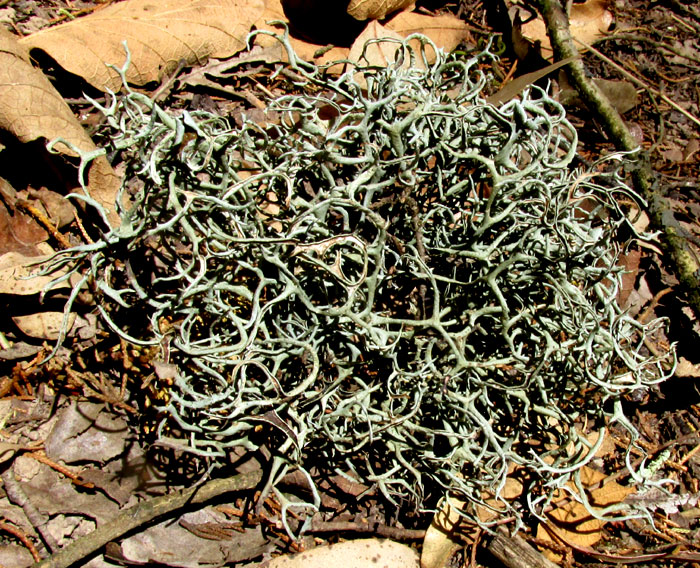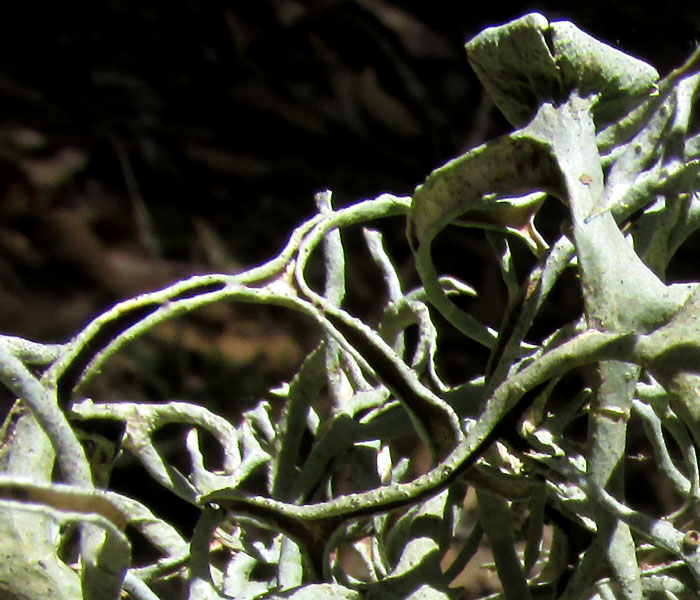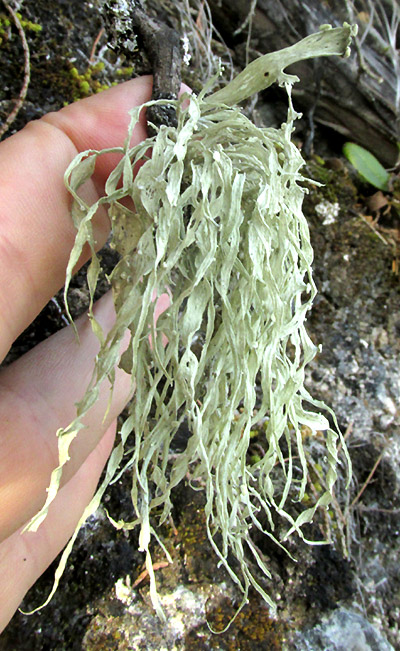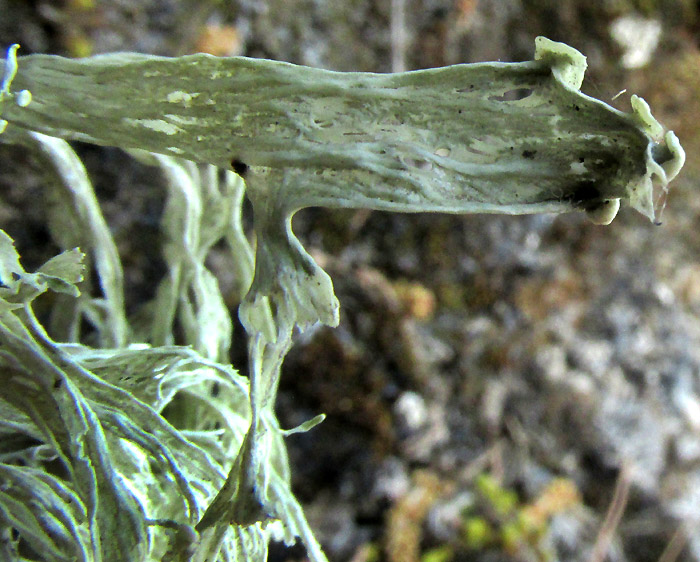Excerpts from Jim Conrad's
Naturalist Newsletter
entry from field notes dated April 14, 2022, taken in disturbed/reforesting borderline cloudforest within 1km of Valle de los Fantasmas, elevation ±2,320m (7600 ft), about 40kms (24 miles), straight-line, ESE of San Luis Potosí, San Luis Potosí state, MÉXICO, (~N22.06°, ~W100.62°)
CARTILAGE LICHEN

On the forest floor of the oak/juniper forest mantling the mountain slope, it's not unusual to find clumps of lichen like what's seen above. The clumps aren't attached to anything, for they've fallen from trees. The dislodged clumps are so commonly seen that one suspects that there's a cause, maybe squirrels or a recent strong wind, or possibly the species just does this when it grows to this size, for most clumps are of similar dimensions.

The relatively slim branches of this fruticose lichen are sometimes round in cross section but more often they're somewhat flattened. Much of the branching is Y-shaped, or dichotomous. On the thicker branch directed toward the above picture's top-right corner, the cup-shaped, brownish item appears to be the very early stage of the formation of an apothecium, the spore-producing structure of the fungal part of the lichen. The body's brown color suggests that its development may have been aborted for some reason.

The above shows that larger stems are likely to flatten out and curl their margins until an open-sided cylinder is formed, and this is a very noteworthy feature.
I've encountered similar lichens before, for example the Powdery Twig Lichen on the coast of the Yucatan. That was a member of the genus Ramalina, so an Internet image search was made on Ramalina species occurring in Mexico.
Ramalina farinacea commonly occurs in parts of North America, but it's rarely documented in Mexico. That species' stems don't flatten as readily as our lichen's, and the flattened sections hardly ever form open-sided cylinders. Also it seems to readily produce apothecia fruiting bodies, while our lichen doesn't have a well formed apothecium on it.
Ramalina calicaris, very rarely documented in Mexico, does habitually produce flattened stems whose margins curl up to form open-sided cylinders, plus pictures of it often show plants with no apothecia. However, the surfaces of that species's stems are smooth while ours are fairly warty, the bumps apparently being pseudocephalas, which facilitate gas exchange through the lichen's surface.
Then there's Ramalina fraxinea, which readily produces flattened stems, but normally it bears many apothecia, plus the flattened stems hardly ever form open sided cylinders as our does -- except for one of its several varieties, Ramalina fraxinea var calicariformis. In fact, that variety is so similar to both our pictured species and Ramalina calicaris -- even seldom producing apothecia -- that the Lichensmaritimes.Org web page for it advises that to distinguish the two taxa "a reliable determination often requires ascospore analysis," which is beyond our ability. It looks like we have one of those two taxa.
Since Ramalina fraxinea has been collected near our San Luis Potosí location (A.F. Whiting #476, 477, 479, 689, 690 and 741, at Charcas, San Luis Potosí), while Ramalina calicaris is seldom recorded in Mexico, and Ramalina calicaris is smooth skinned while Ramalina fraxinea var calicariformis has warty skin like our fallen lichen, our plant seems like the latter.
Despite bumpiness not being a very convincing character, I'm filing our plant under the name RAMALINA cf. FRAXINEA var. CALICARIFORMIS, the cf. meaning that I hope a genuine lichenologist will see our pictures and "confirm" the ID.
The Lichensmaritimes.Org website describes the species as "Frequent on slightly nutrient-rich bark of trees in well-lit and windy exposed habitats," which fairly well matches where our fallen tufts were found.
entry from field notes dated May 4, 2023, taken about 150m uphill on NE-facing slope, above intersection of road from Hwy 120 to San Joaquín, with road to El Doctor; juniper and pine forest on limestone bedrock; elevation ±2425m (7950 ft); Eastern Sierra Madre mountains of east-central Querétaro state, MÉXICO, (N20.88°, W99.62°)
THE ABOVE, BUT FROM A MORE SHELTERED ENVIRONMENT?

The above fruticose lichen looked like a handful of tattered, bleached linguine stuck on a broken tree branch. We were on a steep slope usually in shade.

Up close, the dangling ribbons could be seen bearing small, mushroom-shaped apothecia, and the margins of the flat thalli sometimes curled so that they met, briefly forming a cylinder. The thalli had many holes in them. Here's a closer look at a broad thallus with holes, and apothecia along its margins:

This lichen looks little like the one featured at the top of this page, yet it appears to answer to features making it the same species. The above lichen had been in a more exposed environment and apparently was very dried out. The current shaded side of a northeastern-facing slope is moister, so the thalli have less need to curl into themselves to save water. This might explain why this individual in a less severe habitat bears numerous apothecia, too.
Also, maybe this species from its beginning develops either more or less tubular thailli, and bears more or fewer apothecia, depending on the yearly supply of moisture, sunshine and wind.